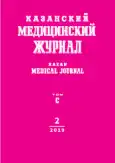Possibilities of the use of shear wave elastography of the liver in pregnant women infected with viral hepatitis B and C
- Authors: Saryeva EG1
-
Affiliations:
- Azerbaijan Medical University
- Issue: Vol 100, No 2 (2019)
- Pages: 345-350
- Section: Clinical experiences
- URL: https://journals.rcsi.science/kazanmedj/article/view/11549
- DOI: https://doi.org/10.17816/KMJ2019-345
- ID: 11549
Cite item
Full Text
Abstract
Aim. To determine the diagnostic possibilities of using liver shear wave elastography in pregnant women with hepatitis B and C viral infection.
Methods. The study included 87 women with hepatitis B and C viral infections admitted to the Center of Clinical Medicine №1 and Educational and Therapeutic Clinic of Azerbaijan Medical University (basis of the department of obstetrics and gynecology 2 of Azerbaijan Medical University) in 2016 to 2017 aged 18-45 (average age 31.4±7.1 years), and 50 uninfected women with physiological pregnancy matched by the age (average age 30.6±6.8 years). Infected women were divided into two groups: 70 pregnant women (group 1) and 17 women (group 2), who were non-pregnant at the time of the study (average age 29.8±7.2 and 30.9±6.7 years, respectively). Women with physiological course of pregnancy were included into group 3 (average age 30.6±6.8 years). Groups of pregnant patients were matched by age, gestation age and parity (p ˃0.05). All patients underwent clinical and biochemical analyses and shear wave elastography of the liver. The obtained data were processed using the methods of variation statistics with calculation of mean and standard error (M±m), Mann-Whitney U-test, Spearman's rank correlation coefficient.
Results. In 52.9±6% of the examined pregnant women with viral hepatitis, hepatitis B was identified, in 47.1±6% - hepatitis C. According to the results of shear wave elastography, the average density of the liver in these patients was 7.2±1.0 kPa. An increase in liver density in pregnant women with viral hepatitis was not accompanied by changes in the size of the liver (only 1 patient had hepatomegaly). In 71.4±5.4% of the patients, F1 degree was revealed, in 20.0±4.8% - F2, in 5.7±2.8% - F3, in 2.9±2.0% - F4. İn comparison with infected patients without pregnancy, pregnant women with viral hepatitis B and C had more severe degree of fibrosis [F1 was significantly less frequent (p ˂0.05), and F2 was significantly more frequent (p ˂0.05)], and also had F4 degree, which was not observed in non-pregnant. In infected pregnant women, there was a positive correlation between liver echogenicity and density of its tissues (p=0.495; p <0.001).
Conclusion. In pregnant women with hepatitis B and C viral infection, the use of shear wave elastography allows detecting various degrees of liver fibrosis by a non-invasive method in the early stages, even in the absence of marked clinical and laboratory changes.
Full Text
##article.viewOnOriginalSite##About the authors
E G Saryeva
Azerbaijan Medical University
Author for correspondence.
Email: elladasariyevaatu@mail.ru
Baku, Azerbaijan
References
- Lemeshko Z.A. Radiology in gastroenterology. Rossiyskiy zhurnal gastroenterologii, gepatologii, koloproktologii. 2011; (1): 79–84. (In Russ.)
- Duysenova A.K., Kurmanova G.M., Zhusupova R.T. et al. Prevention of adverse outcomes of viral hepatitis. Vestnik Kazakhskogo Natsional'nogo meditsinskogo universiteta. 2013; 4 (2): 276–280. (In Russ.)
- «Global Health Sector Strategy on Viral Hepatitis 2016–2021» towards ending viral hepatitis. June, 2016. WHO Document Production Services. Geneva, Switzerland. 2016; 56 p.
- Pavlov Ch.S., Glushenkov D.V., Ivashkin V.T. Modern possibilities of elastometry, fibro- and acti-test in the diagnosis of liver fibrosis. Rossiyskiy zhurnal gastroenterologii, gepatologii, koloproktologii. 2008; 18 (4): 43–52. (In Russ.)
- Ryabova E.N., Rykhtik P.I., Shkalova L.V. et al. Noninvasive assessment volume of active parenchyma of the liver at the patients with liver cirrhosis and portal hypertension as a factor of prognosis outcomes after operation portosystemic shunting. Radiologiya — praktika. 2012; (3): 77–82. (In Russ.)
- Rudenko O.V., Safonov D.V., Rykhtik P.I. et al. Physical basis of elastography. Radiologiya — praktika. 2014; (3): 41–50. (In Russ.)
- Berdnikov S.N., Sholokhov V.N., Patyutko Yu.I. et al. Elastometry and elastography in the differential diagnosis of hyperechoic formations of the liver. Annaly khirurgicheskoy gepatologii. 2014; 19 (3): 40–45. (In Russ.)
Supplementary files






